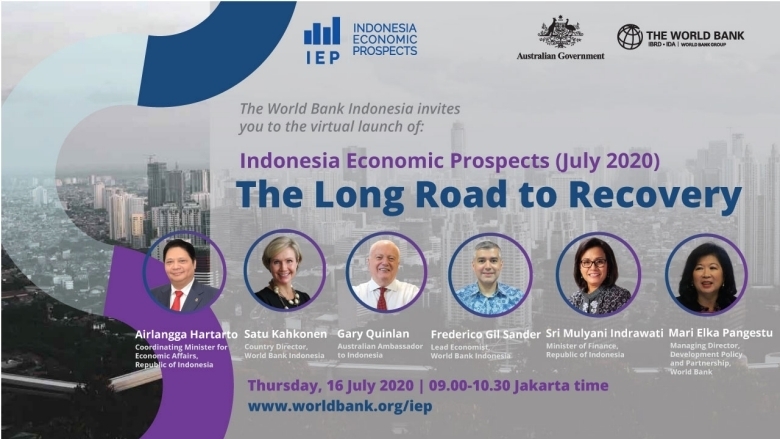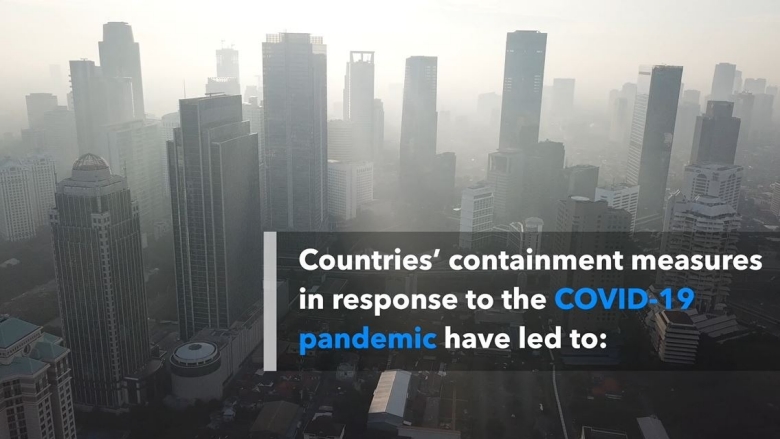MULTIMEDIA

VIDEO
Click the image above to watch the launch event. To listen the audio in Bahasa Indonesia, please go to Bahasa Indonesia page.
The Indonesia Economic Prospects (IEP), a successor of the Indonesia Economic Quarterly, is a six-monthly World Bank report that aims to provide an impartial and up-to-date assessment of recent global and domestic macroeconomic developments, outlook and risks, as well as specific development challenges for the Indonesian economy.
Watch the session videos:
- Welcome address: Satu Kahkonen, Country Director, World Bank Indonesia [watch video]
- Opening remarks: Gary Quinlan, Australian ambassador to the Republic of Indonesia [watch video]
- Keynote speech: Airlangga Hartarto, Coordinating Minister of Economic Affairs, Republic of Indonesia [watch video]
- Presentation on “Recent Economic Developments and the Long Road to Recovery”: Frederico Gil Sander, Lead Economist, World Bank Indonesia [Recent economic developments and outlook presentation video] [The long road to recovery presentation video]
- Short clips from Indonesia economists: “What would be the one key priority for Indonesia to recover from the COVID shock?” [watch video]
- Chatib Basri, Co-Founder and Sr. Partner, Creco Research, Senior Lecturer, Department of Economics, UI
- Vivi Alatas, Economist, CEO Asa Kreativa
- Helmi Arman, Chief Economist, Citibank Indonesia
- Panel discussion on “The Long Road to Recovery” [watch video]
- Sri Mulyani Indrawati, Minister of Finance, Republic of Indonesia
- Mari Elka Pangestu, Managing Director, Development Policy & Partnerships, World Bank
Key findings:
- In line with significantly weaker domestic and external demand .
- On the production side, there was broad-based slowdown across the sectors; manufacturing, construction and low value-added sectors saw near halving in their sectoral growth rates from Q4 2019. In contrast, growth of modern, knowledge-intensive services sectors, including digital, financial, education and health services accelerated.
- The Government has announced a package of 4.3 percent of GDP. Together with lower revenues, the fiscal deficit is expected to widen to 6.3 percent of GDP in 2020. The package includes larger allocations to the health sector, significant increases in social assistance, credit programs for SMEs and equity injections for banks that restructure SME loans.
- Without measures to mitigate the shock, the pandemic would lead poverty to increase by 2.0 percentage points. The substantial increase in social assistance spending as part of the Government’s mitigation package is therefore critical: if appropriately targeted and fully disbursed with minimal leakage, the package would significantly mitigate the impact of the pandemic on poverty.
- The focus of this edition is therefore on overcoming these challenges and setting up Indonesia for a sustainable and inclusive economic recovery.
- To support a safe reopening of the economy, the priority remains to have in place a robust health system. Safely and sustainably reopening thus requires continued improvements in health system capacity and readiness, including continued expansion of testing and surveillance.
- Many businesses will require continued support to ride out the economic downturn. Firms will need support to gradually re-start or expand production, while conditions need to be in place to facilitate the entry of new firms; these include addressing long-standing constraints to investment.
- The unemployed need to be supported in their job search and upskilling to meet employer needs. Moreover, .
- COVID-driven cuts to public capital spending and postponements of infrastructure projects need to be reversed to avoid putting at risk the Government’s growth-enabling infrastructure agenda.
- To flatten the debt curve, temporary fiscal measures need to be gradually unwound, and revenues increased.
MULTIMEDIA

VIDEO
Jul 16, 2020